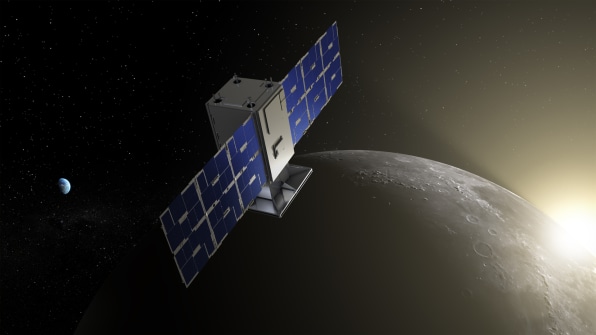- | 8:20 am
NASA’s Capstone mission will test-drive Gateway’s lunar orbit
The $30 million mission is an initial step in returning humans to the Moon and a case study in NASA’s efforts to embrace small business diversity.

A 55-pound satellite will become the first spacecraft to test-drive the unique lunar orbit chosen for NASA’s planned Gateway space station—all while demonstrating the space agency’s embrace of smaller players in private industry.
The microwave-sized Cislunar Autonomous Positioning System Technology Operations and Navigation Experiment (CAPSTONE) is slated to launch June 6 aboard a Rocket Lab Electron rocket from New Zealand for a four-month journey to orbit. There, it will spend six to 18 months measuring radiation impact and gauging how computer models match up to actual orbital characteristics and propulsion requirements. It will also test next-generation operating tools and communication abilities with Earth and other spacecraft. At mission’s end, the probe will crash onto the lunar surface.
“In the context of Gateway, the power of the orbit with larger missions is it marries the upsides of a low lunar orbit, which is surface access to the Moon, with benefits of the distant retrograde orbit, further away from the Moon, [which] is the fuel efficiency,” says Jenn Gustetic, director of NASA’s Early-Stage Innovations and Partnerships for Small Business Innovation Research. “It provides different capabilities for human exploration.”

[Illustration: NASA/Daniel Rutter]
The $30 million mission is among NASA’s initial steps for its return-to-the-Moon Artemis program. Capstone will test the eventual orbit of the Gateway lunar outpost that will serve as a springboard to the lunar surface or outward to Mars and beyond. The unique elliptical shape of its orbit, which requires a week to complete, offers better fuel economy and strategic launch points. Balanced between Earth, Moon, Sun, and even Jupiter gravities, it’s a stable loop that requires ten times less propulsion for a spacecraft to maintain than a low-altitude circular orbit, bringing Capstone within 1,000 miles of the lunar South pole and 43,500 miles over the other. It also provides the advantage of an unobstructed view of Earth for uninterrupted communication between the Earth and Moon.
SMALL BUSINESS ENTRÉE
Beyond advancing the Artemis mission, Capstone also represents the space agency’s effort to increasingly engage smaller industry players and innovation sources.
Historically, NASA mission contracts have gone to larger aerospace conglomerates. “We’re seeing that replaced by a more inclusive model,” says Gustetic. “We gain insight on industry trends, and cutting-edge technologies and ideas from nimble startups, but industry partners and startups also gain access to NASA’s resources and experts.”
Agency initiatives, such as the Small Business Innovation Research and Small Business Technology Transfer Program and NASA Solve, offer seed funding, grants, and awards for small business, academic, and citizen scientist innovators for more than 700 projects a year. Recipients retain intellectual property rights, but are responsible for other legal protections, like patents. Over time, says Gustetic, “you can see the results of those investments translating into real mission success.”
Capstone is such an example, not just of investment returns, but of seamlessly marrying varied levels of experience and technologies among contractors. Tethers Unlimited, which designed Capstone’s communications system, has applied more than 50 awards over three decades to technologies across NASA and commercial industry. By comparison, its younger partners parlayed a collective handful of awards into research that eventually lead to mission technologies, such as Stellar Exploration‘s propulsion process, Advanced Space’s trajectory layout, Tyvak Nano-Satellite Systems‘ CubeSat design, and Rocket Lab’s launch system.
More recently, NASA has been using its funding operations to enable greater accessibility and diversity. Last month, it awarded some $50 million to more than 300 small businesses and research institutions, nearly a third of which were first-time recipients and a quarter minority-owned. Opening its doors to a wider range of contributors will not only feed increasingly ambitious missions in space, but possibly lead to solutions to problems back on Earth.
“One reason why some small businesses may consider getting even one SBIR award is because it gives them the mechanism to engage with other parts of the government to buy their goods and services in a more streamlined way,” says Gustetic.






































